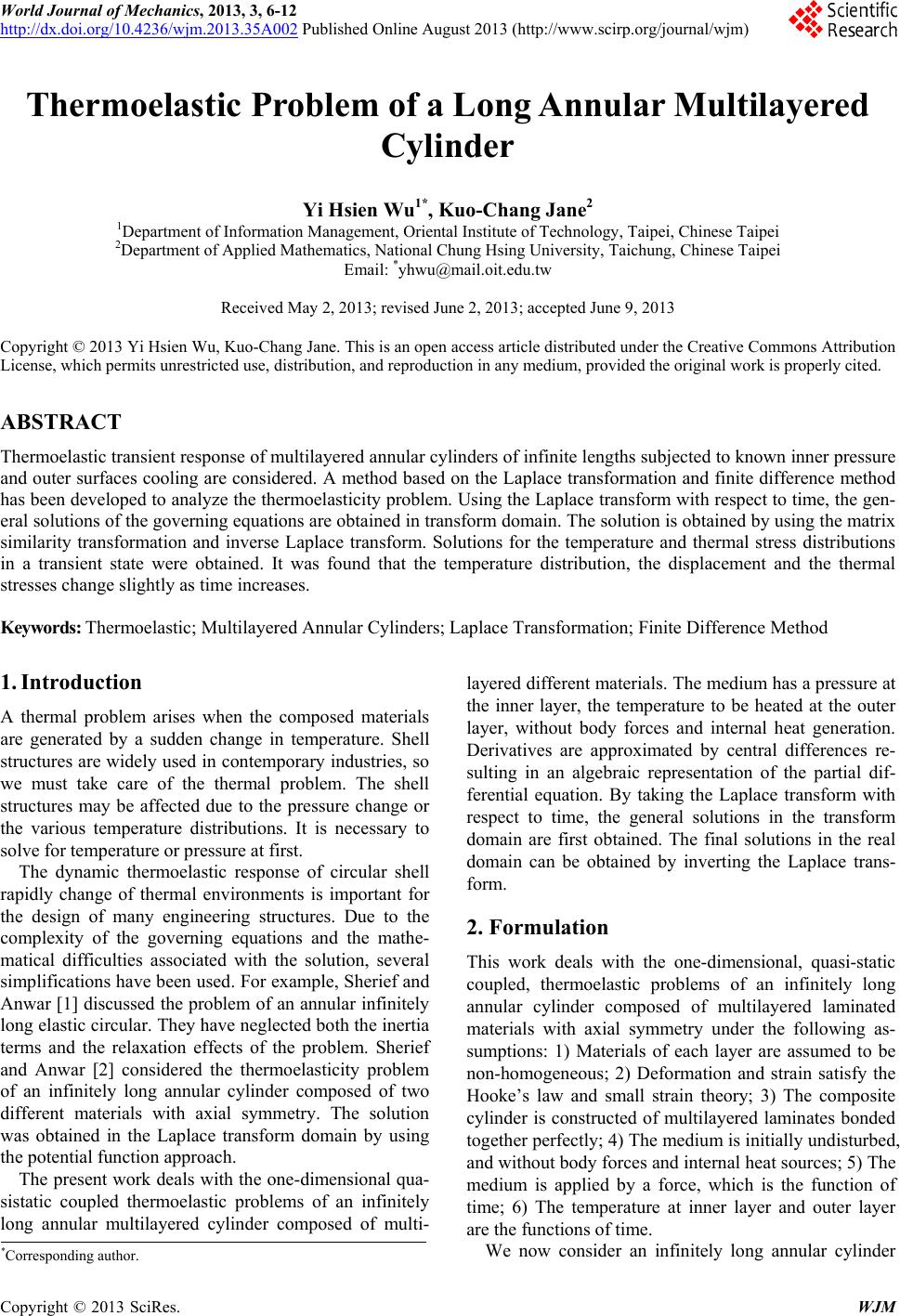
World Journal of Mechanics, 2013, 3, 6-12
http://dx.doi.org/10.4236/wjm.2013.35A002 Published Online August 2013 (http://www.scirp.org/journal/wjm)
Thermoelastic Problem of a Long Annular Multilayered
Cylinder
Yi Hsien Wu1*, Kuo-Chang Jane2
1Department of Information Management, Oriental Institute of Technology, Taipei, Chinese Taipei
2Department of Applied Mathematics, National Chung Hsing University, Taichung, Chinese Taipei
Email: *yhwu@mail.oit.edu.tw
Received May 2, 2013; revised June 2, 2013; accepted June 9, 2013
Copyright © 2013 Yi Hsien Wu, Kuo-Chang Jane. This is an open access article distributed under the Creative Commons Attribution
License, which permits unrestricted use, distribution, and reproduction in any medium, provided the original work is properly cited.
ABSTRACT
Thermoelastic transient response of multilayered annu lar cylinde rs of infinite leng ths subjected to known inner pressure
and outer surfaces cooling are considered. A method based on the Laplace transformation and finite difference method
has been developed to analyze the thermoelasticity problem. Using the Laplace transform with respect to time, the gen-
eral solutions of the governing equations are obtained in transform domain. The solution is obtained by using the matrix
similarity transformation and inverse Laplace transform. Solutions for the temperature and thermal stress distributions
in a transient state were obtained. It was found that the temperature distribution, the displacement and the thermal
stresses change slightly as time increases.
Keywords: Thermoelastic; Multilayered Annular Cylinders; Laplace Transformation; Finite Difference Method
1. Introduction
A thermal problem arises when the composed materials
are generated by a sudden change in temperature. Shell
structures are widely used in contemporary industries, so
we must take care of the thermal problem. The shell
structures may be affected due to the pressure change or
the various temperature distributions. It is necessary to
solve for temperature or pressure at first.
The dynamic thermoelastic response of circular shell
rapidly change of thermal environments is important for
the design of many engineering structures. Due to the
complexity of the governing equations and the mathe-
matical difficulties associated with the solution, several
simplifications have been used. For example, Sherief and
Anwar [1] discussed the problem of an annular infinitely
long elastic circular. They have neglected both the in ertia
terms and the relaxation effects of the problem. Sherief
and Anwar [2] considered the thermoelasticity problem
of an infinitely long annular cylinder composed of two
different materials with axial symmetry. The solution
was obtained in the Laplace transform domain by using
the potential functio n approach.
The present work deals with the one-dimensional qua-
sistatic coupled thermoelastic problems of an infinitely
long annular multilayered cylinder composed of multi-
layered different materials. The medium has a pressure at
the inner layer, the temperature to be heated at the outer
layer, without body forces and internal heat generation.
Derivatives are approximated by central differences re-
sulting in an algebraic representation of the partial dif-
ferential equation. By taking the Laplace transform with
respect to time, the general solutions in the transform
domain are first obtained. The final solutions in the real
domain can be obtained by inverting the Laplace trans-
form.
2. Formulation
This work deals with the one-dimensional, quasi-static
coupled, thermoelastic problems of an infinitely long
annular cylinder composed of multilayered laminated
materials with axial symmetry under the following as-
sumptions: 1) Materials of each layer are assumed to be
non-homogeneous; 2) Deformation and strain satisfy the
Hooke’s law and small strain theory; 3) The composite
cylinder is constructed of multilayered laminates bonded
together p erfectly; 4) Th e medium is initiall y undisturb ed,
and without body forces and internal heat sources; 5) The
medium is applied by a force, which is the function of
time; 6) The temperature at inner layer and outer layer
are the functions of time.
We now consider an infinitely long annular cylinder
*Corresponding a uthor.
C
opyright © 2013 SciRes. WJM